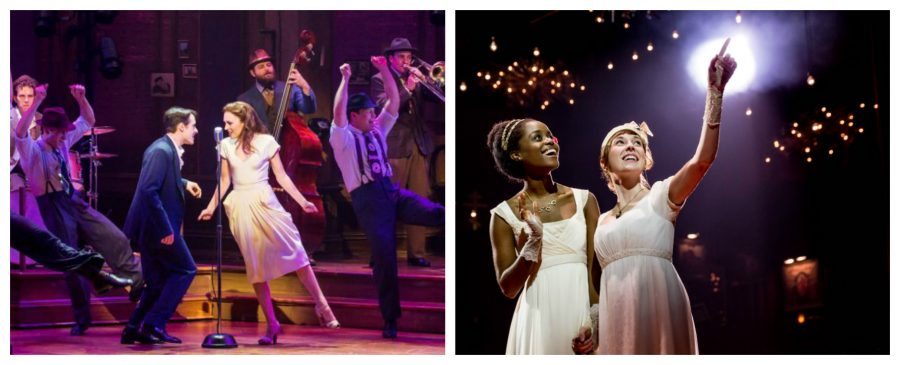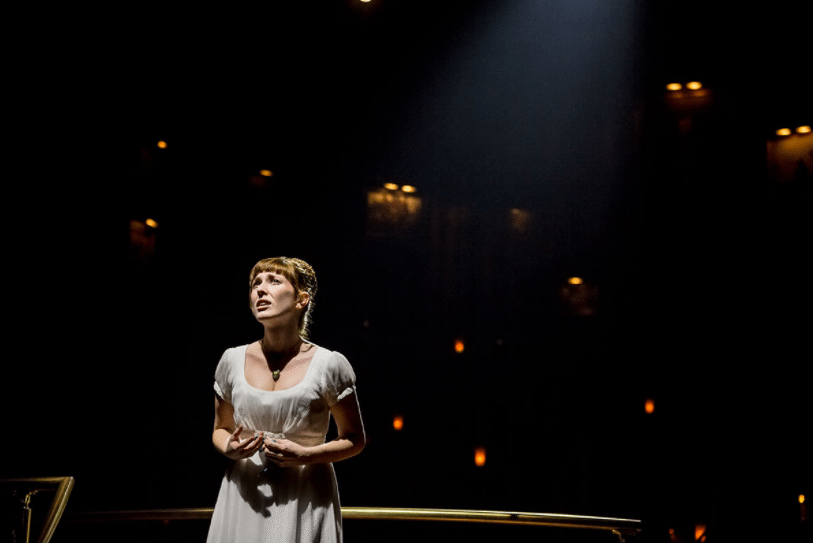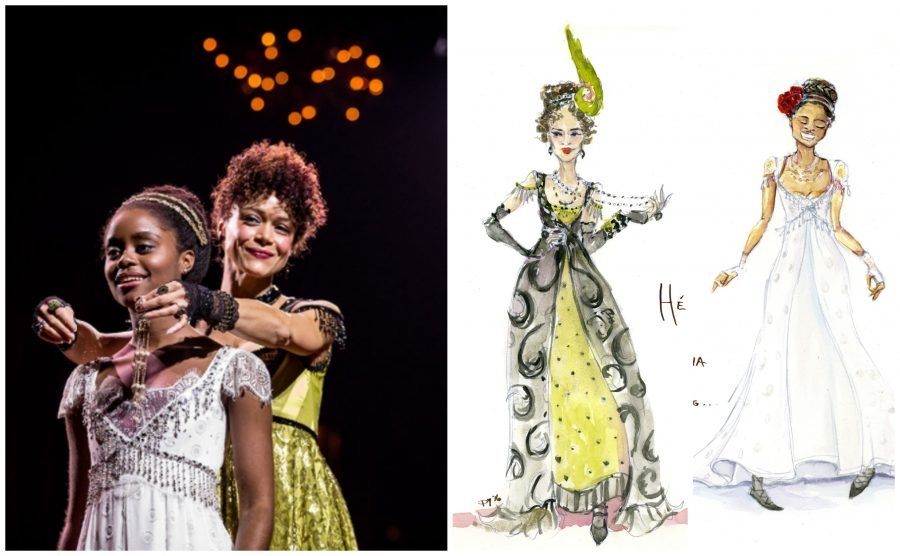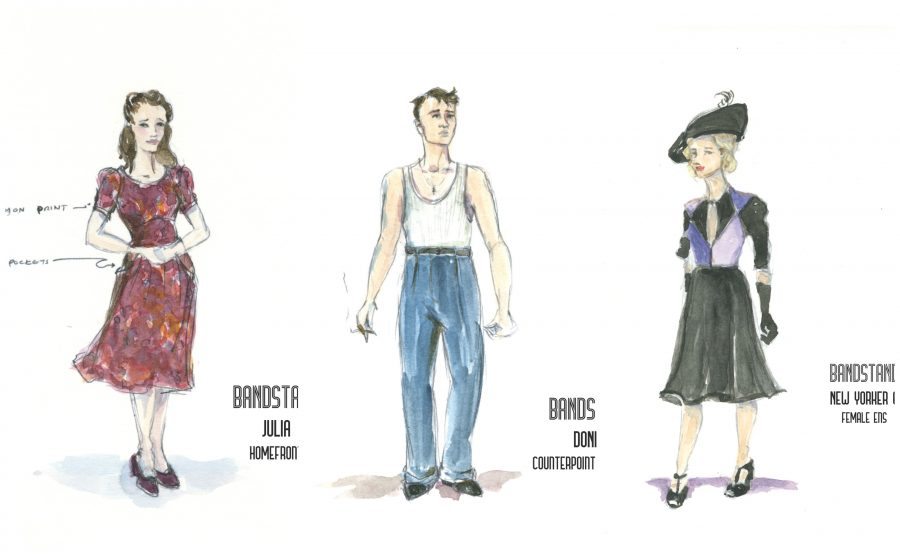

From Imperial Russia to Neverland and Sherwood Forest, costume designer Paloma Young has become the go-to woman for clothes that can evoke fantasy while being grounded in reality. Her work can be currently seen on Broadway in Bandstand and Natasha, Pierre & The Great Comet of 1812 (for which she received her second Tony nomination, she won in 2012 for her work in Peter and the Starcatcher) two shows that couldn’t be more different than the other. Bandstand takes place in the post-WWII years and deals with working class people and army veterans who try to find joy through music, while the characters in The Great Comet are conniving aristocrats who find a cure for their ennui in manipulation and forbidden affairs. Set more than a century apart from each other, the shows are a perfect showcase for Young’s versatility, she has also designed contemporary pieces like Verite and fairy tales like Tangled and Frozen.
In The Great Comet audience members have the opportunity to see Young’s work up close, as the actors spend most of the show moving within audience reach, allowing the details in the costumes to be admired and appreciated in a unique way. But one gets the sense Young’s work would be as complex even if we were sitting a mile away from the actors, she puts great emphasis in how the fabrics move, how the light reflects on them, and the weight they carry onstage (she makes headpieces in an opera scene seem like they’re floating above the actors’ heads). I spoke to Young about the secrets she sews in the costumes, her design philosophy and how her perception of each character affects the way they look.
You’ve been with The Great Comet since it began, what was the biggest upgrade you gave the costumes when you moved to Broadway?
We have a much bigger ensemble so I wanted their costumes to fill the stage a little bit more without hitting people in the face. I also spent more time on the detail, because we truly were gonna have some people see things that other people would not, so I wanted them to feel they were seeing something special.
I put secrets in the costume for the actor’s benefit Click To TweetSince you mentioned detail, what are you particularly proud of and would like to direct our attention to when we look at the costumes?
I’d bought a 90s vintage Oksana Baiul t-shirt on the internet and I knew it was destined for great things, so one of our violists wears it, he spends a lot of time in the mezzanine. We got a white denim vest and stitched the t-shirt, we added some rhinestones and a whole lotta extra stuff in there, so it’s definitely a fun surprise. He’s mentioned that at the stage door people remember him by the vest. It would also be fun if you brought a Russian speaker along with you, or if you are a Russian speaker, we have a lot of details in Cyrillic, we have some passages from War and Peace scribbled on the ensemble shoes, like the way you’d do in junior high. We didn’t want to have a lot of English in the show, we wanted it to feel authentically punk, so the writing in a lot of the t-shirts is in Russian.

I know many costume designers sew details in the costumes that we never see, but that make a difference for the actors. Are there any of those details in your costumes?
I do that often, I put secrets in the costume for the actor’s benefit, they’re often about the backstory for the character, or something an actor tells me. But in the case of The Great Comet, the show has an overall sense of welcoming and giving, when the show starts the actors give dumplings to the audience and introduce themselves, there’s a sense of wanting to connect to the audience, so in this case there are many Easter eggs in the costumes that even the actors themselves are discovering over time, because there are so many textures and layers to them. But they’re all openly shared with the audience, the secrets are shared with whoever that person is sitting next to. I do have one non-visible thing in the show though, in Imperial Russia, starting with Peter the Great there was this attempt to westernize Russian culture, so Peter the Great made this law that within the city of St. Petersburg you couldn’t wear traditional Russian clothing, you had to wear trousers, tailcoats, and also you couldn’t have a beard because in the West men shaved. If you wanted to have a beard you had to pay a special tax, if the police stopped you because of your beard you had to produce a token that proved you’d paid the Beard Tax, these tokens were used from the 17th till the 19th century, so I got replicas of them and gave them to anyone in the cast who has a beard, just in case the KGB shows up.
That’s crazy, every time I think about Russian men I think about beards! The Great Comet and Bandstand both have a lot of dancing, what are the challenges of creating costumes that look great but also move well?
The bigger challenge was on Bandstand because we were trying to create a world that would seem you were in Cleveland in 1945, we wanted it to feel cinematic, real and not a costume-y interpretation. A lot of 1940s clothing for women wasn’t built to move the legs a lot, they had straighter skirts, so we had to play a lot with patterns, hiding things in cleats, or making sarong-style skirts that could work for crazy choreography but would look vintage when the characters were in normal citizen mode.
I love those costumes that transform into different costumes. What’s the right term for those?
I’d call it a trick costume or transformation costume, I don’t know there’s an industry standard name for those. Quick change costumes maybe?
Would you rather create two different pieces or do you like creating those as well?
They can be fun if they’re done for the right reasons and if they fit the story. In Bandstand in that moment, the excitement of the band and Donny and Julia going to New York, and feeling they’re moving up in the world...Andy and I wanted to emotionally capture that moment when your life is about to change for the better, which might not always be the case. So there’s two ways to do those costumes, one where you manipulate the lighting and the scene so it feels like a Cinderella transformation, the dress transforms into something else and you don’t know how it happened. What we did is you can see it happen, we see Laura open the dress and you can almost see the mechanism at work, we’re watching her change faster. We see the other outfit go away. I recently did a Frozen for a Disney cruise line and that’s more magical, you want the costume to feel like it’s disappearing rather than transforming, sometimes you do things with magnets and people hidden in the floor, it all depends on what the transition is calling for dramaturgically.

You’ve had the chance to create costumes for original pieces, have you thought about your costumes being the inspiration for designers in revivals or tours?
I don’t think about that very much, I designed Peter and the Starcatcher several years ago, and as that show started being done across the country I remember being very disappointed in seeing designers across the country were basically trying to cheaply copy my costumes, but didn’t seem to understand the story behind them. My first instinct was to be frustrated as opposed to being flattered, as designers we struggle a lot to get the point across that our work is intellectual property, the same way the music, lyrics and choreography are. I want my costumes to be inspirational, but I’ve also seen productions which are completely different, some that have been inspired by my work, and those are genuinely flattering.
When I’m designing something new, especially when I feel there are iconic characters within the show I want to find elements in the design that don’t turn the character into a caricature but that will define them in a way that every time you see them, the design will be an intrinsic part of the character. Sonya in The Great Comet always wears a locket, poofy sleeves, bangs and a white dress, watching her throughout the show is exciting because you get to see all the riffs on that, but she still has the locket, poofy sleeves and bangs. Anyone who knows the show will be able to pick up the character from a line drawing. Not that every show I do will necessarily become a classic people will see down the road, but I like to think about those things in the design.
I love the costumes for Hélène, they reminded me of a snake or some sort of reptile…
Yeah!
How do you go about designing characters for villains or less likable characters?
My feelings for the characters influence the way I design the costumes, but I find elements to be excited about in every character even if they’re a horrible person. There are things about Hélène and her brother Anatole that are really delicious, they are complicated, layered characters, even in these 70 pages of War and Peace they are villains, they are more layered than that. With Amber Gray’s performance especially, and her big song “Charming” which was written inspired by the bassline of a Prince song, so there’s this flamboyant, rococo, glam feel to that song and that was the inspiration to the sleeves, I wanted it to feel like she could be in a Prince video while existing in 1812. Hélène is introduced as a slut, and there was a discussion where some producers wanted her to be in a red dress, but that feels very on the nose. To me her character was less about what society thought about her sexuality, but how she reveled in her sexuality and used it to manipulate other people. She is snake-y, she moves around the edges manipulating what happens to feel she’s in power, so I wanted to use the green, which was the color of the Russian military incidentally, but I pushed to a more acidic, poisonous green and looked for textures that felt scaly and reptilian, so it wasn’t unintentional that you felt that.
I find elements to be excited about in every character even if they’re a horrible person Click To TweetSomething else Bandstand and Comet have in common is how sexy the costumes are without being revealing. As a designer are you interested in fighting this idea that you need to show more to convey sensuality?
I like to pay attention to the choreographers, and with something like Comet I have the chance to see an actor develop a character over time, I had the benefit of making the show at Ars Nova with no money which meant I had to beg, borrow and steal to put together the designs. I wasn’t building things from scratch, but it was a benefit because by the time I was able to design their costumes from scratch I was able to know that I wanted a lot of collarbone and upper arm, but not a lot of slit in legs. I try very hard to watch what my collaborators are doing and support that with the costume and not undermine it by trying to tell the whole story with the costume.
 I read recently that Edith Head wanted to hide Audrey Hepburn’s shoulders in Roman Holiday because she thought they were too pointy, but then when Audrey met Hubert de Givenchy and he started making her clothes he always showed her shoulders which eventually became one of the thing we most associate with her. Is there a body part you find particularly appealing and want to bring attention to that others might shy away from?
I read recently that Edith Head wanted to hide Audrey Hepburn’s shoulders in Roman Holiday because she thought they were too pointy, but then when Audrey met Hubert de Givenchy and he started making her clothes he always showed her shoulders which eventually became one of the thing we most associate with her. Is there a body part you find particularly appealing and want to bring attention to that others might shy away from?
It’s also about the changing times, Audrey Hepburn is very svelte in a sense that if someone in the 40s saw a picture of her they would have thought she needed to eat a sandwich. But by the 60s and you have people like Twiggy and the aesthetic of the times have changed there are new iconic measures of beauty. Like most people I’m tuned to what in our culture is the ideal of beauty, on Bandstand especially there are certain fashion details that I look for in the period that I’m representing that resonate currently. In the 40s in sundresses there were a lot of crop tops which you can see having a resurgence now, so I brought those details into the sexy dresses, so they also feel sexy to the modern eye. I feel they seem sexy because our culture is fixated on the idea of looking very healthy, and those dancers have amazing abs and arms, they’re not super waify, so these costumes can live within the period and also show off the strength of these performers.
On your bucket list, who are the actor, actress and musical you dream of designing for?
I like meeting new people, so I’m excited for every new person I get to work with, as opposed of dreaming about designing for one person someday because I don’t want to be disappointed. I’m most excited to work with the actors I’m working with next. As far as my dream show, I love doing new work, and I say it as a joke sometimes, but if I ever was to do a revival or a musical based on a movie, I’d love to design Troop Beverly Hills which was my absolute favorite movie as an 8 year old.
If there was a semi-controversial item of clothing you could have everyone embrace as the next big thing what would it be?
I want men to start wearing high waisted pants again. It’s so flattering, it’s so sexy, I loved doing Bandstand because that’s my way of showing the world: look how good these men look in these pants. Stop it with these low rise pants, and muffin tops coming over them. High waited pants for men forever!
For more on Paloma Young visit her official site.